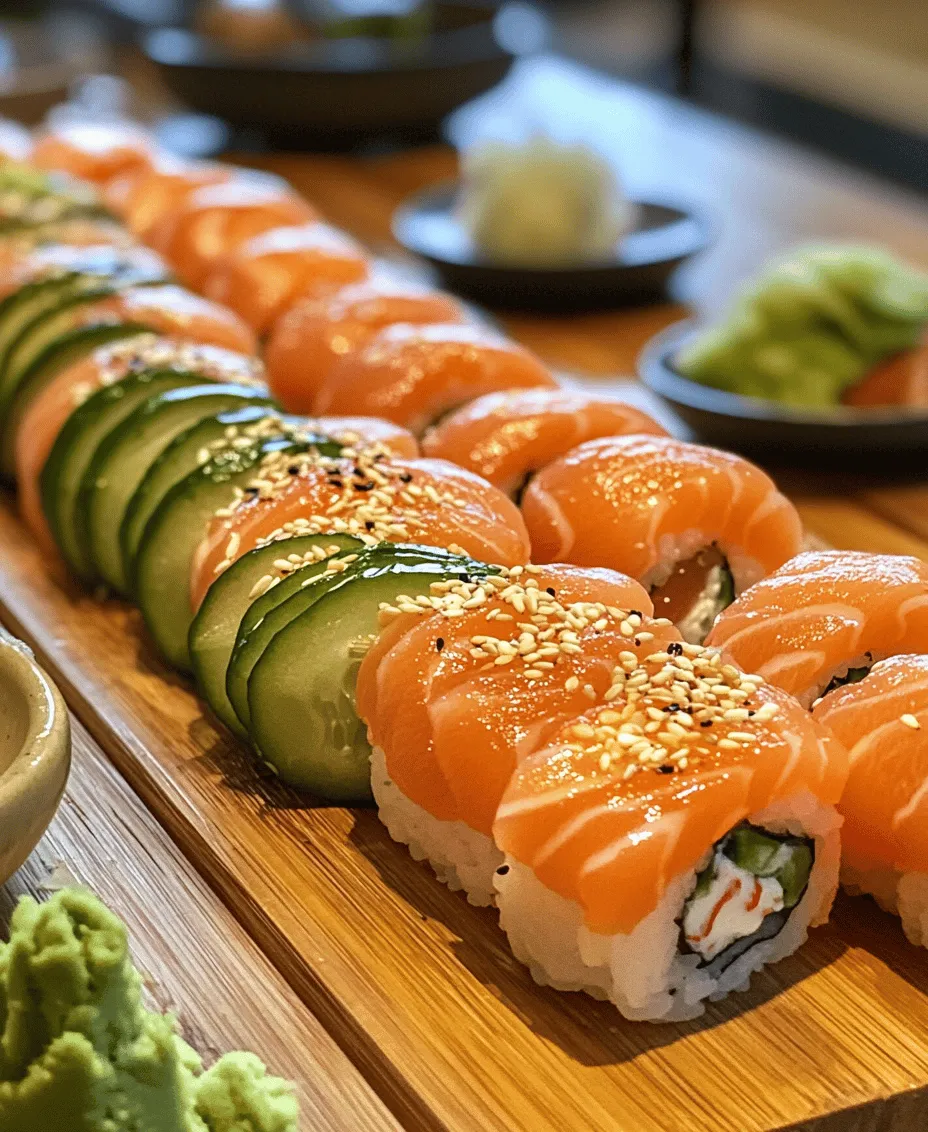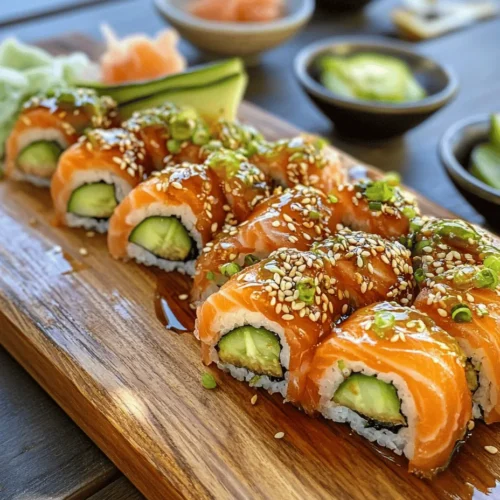Introduction
Baked Salmon Sushi Rolls are a delightful fusion of flavors, combining the rich taste of salmon with the satisfying texture of sushi rice and fresh vegetables. This recipe offers a simple yet elegant way to enjoy sushi at home without the need for raw fish. Perfect for gatherings or a special dinner, these baked sushi rolls are not only delicious but also healthy. With the growing popularity of sushi in various adaptations around the world, baked versions have emerged as a fantastic alternative that caters to those who prefer cooked ingredients. In this article, we will take you through each step of crafting this delectable dish, ensuring you have all the information needed to impress your family and friends.
Understanding Sushi and Its Variations
Exploring the Origins of Sushi
Sushi has a rich history that dates back thousands of years in Japan. Originally, sushi was not the rolled delicacy we know today but rather a method of preserving fish in fermented rice. This technique, known as narezushi, was utilized to ferment fish, allowing it to be preserved for extended periods. Over time, the concept of sushi evolved, leading to the development of various styles that we enjoy today, including nigiri, sashimi, and maki rolls.
Types of Sushi:
1. Nigiri: A hand-formed mound of sushi rice topped with a slice of raw or cooked fish.
2. Sashimi: Thinly sliced raw fish served without rice, focusing on the quality of the fish itself.
3. Maki: Rolled sushi where rice and filling are wrapped in seaweed (nori) and sliced into bite-sized pieces.
As sushi gained popularity outside of Japan, creative adaptations emerged, leading to the birth of baked sushi rolls. This innovation allows for the enjoyment of sushi flavors while appealing to those who prefer cooked ingredients.
The Appeal of Baked Sushi Rolls
Baked sushi rolls present a unique twist on traditional sushi, providing a warm and comforting experience that makes them particularly appealing in colder climates or during the chilly months. Unlike traditional sushi, which often features raw fish, baked sushi rolls use cooked or baked ingredients, making them more accessible to a wider audience.
Health Benefits of Using Baked Ingredients:
1. Lower Risk of Foodborne Illness: Cooking fish eliminates the risk associated with raw seafood, making baked sushi a safer option for those concerned about consuming raw fish.
2. Rich in Nutrients: Baking salmon preserves its omega-3 fatty acids and essential nutrients, contributing to heart health and overall well-being.
3. Versatile Fillings: Baked sushi rolls can be enriched with various vegetables and ingredients, enhancing their nutritional profile while adding flavor and texture.
Ingredients Overview
Sushi Rice Essentials
At the heart of every sushi roll is sushi rice, a short-grain rice that is sticky when cooked, allowing it to hold together beautifully. The texture and flavor of sushi rice are crucial for creating the perfect roll.
Choosing the Right Type of Rice:
When selecting sushi rice, opt for high-quality short-grain rice, which is known for its sticky properties. Brands such as Koshihikari or other sushi rice varieties are excellent choices.
Preparation Techniques:
1. Rinsing: Rinse the rice thoroughly under cold water until the water runs clear. This step removes excess starch, preventing the rice from becoming overly sticky.
2. Cooking: Cook the rice using a rice cooker or on the stovetop, following the package instructions. Once cooked, let it cool slightly before seasoning with rice vinegar, sugar, and salt.
The Star Ingredient: Baked Salmon
Salmon is the standout ingredient in our baked sushi roll. Not only does it add a rich and savory flavor, but it is also packed with nutrients.
Nutritional Benefits of Salmon:
– Omega-3 Fatty Acids: Essential for heart health and brain function.
– High-Quality Protein: Supports muscle growth and repair.
– Vitamins and Minerals: Salmon is rich in B vitamins, selenium, and potassium.
Flavor Profiles of the Ingredients Used in the Salmon Marinade:
The marinade for the salmon typically consists of soy sauce, mirin, and a touch of sesame oil, infusing the fish with umami flavors that complement the sushi rice and other fillings perfectly.
Fresh Fillings and Garnishes
In addition to the main ingredients, fresh vegetables play a crucial role in enhancing the overall flavor and texture of the sushi rolls.
Role of Avocado and Cucumber in Sushi:
– Avocado: Adds creaminess and healthy fats, balancing the flavors of the salmon.
– Cucumber: Provides a refreshing crunch, adding a crisp texture that contrasts beautifully with the softer components.
The Significance of Garnishes:
Garnishes like sesame seeds, pickled ginger, and wasabi not only enhance the presentation of your sushi rolls but also add an extra layer of flavor.
– Sesame Seeds: These tiny seeds offer a nutty flavor and are often sprinkled on top of sushi rolls for added texture.
– Pickled Ginger: A traditional accompaniment to sushi, it aids digestion and cleanses the palate between bites.
– Wasabi: Known for its pungent heat, wasabi adds a kick to the sushi, enhancing the overall flavor profile.
Step-by-Step Preparation Guide
Preparing the Sushi Rice
The first step in crafting your Baked Salmon Sushi Rolls is preparing the sushi rice. Follow these detailed instructions to ensure perfect results.
1. Rinse the Rice: Measure out 2 cups of sushi rice into a fine-mesh strainer. Rinse the rice under cold running water, using your hands to gently swirl the rice. Continue rinsing until the water runs clear, which usually takes about 4-5 minutes. This process removes excess starch and prevents the rice from becoming gummy.
2. Soak the Rice: After rinsing, transfer the rice to a medium bowl and cover it with fresh water. Let the rice soak for about 30 minutes. This soaking process helps the rice grains absorb moisture, promoting even cooking.
3. Cook the Rice: Drain the soaked rice and transfer it to a rice cooker with 2 cups of water (or follow the stovetop method). If using a rice cooker, simply turn it on and let it do its job. If cooking on the stovetop, bring the water to a boil, then reduce the heat to low, cover, and let it simmer for about 15-20 minutes, or until the water is absorbed and the rice is tender.
4. Season the Rice: Once the rice is cooked, transfer it to a large bowl and let it cool slightly. In a small saucepan, combine ¼ cup of rice vinegar, 2 tablespoons of sugar, and 1 teaspoon of salt. Heat over low heat until the sugar dissolves, then drizzle this mixture over the warm rice. Using a wooden spatula, gently fold the rice to incorporate the seasoning without mashing the grains. Allow the rice to cool to room temperature.
Now that we’ve laid the groundwork by understanding the origins of sushi, the appeal of baked sushi rolls, and the necessary ingredients, we can proceed to the next steps in preparing our delicious Baked Salmon Sushi Rolls. In the following sections, we will delve into the preparation of the salmon, assembling the rolls, and baking them to perfection. Stay tuned for the continuation of this delightful culinary journey!

How to Achieve the Perfect Texture and Flavor
Crafting the perfect baked salmon sushi roll requires careful attention to both the preparation of the salmon and the assembly of the rolls. The flavor and texture of the salmon are crucial, as they form the foundation of this dish.
Importance of Marinating and Baking Techniques
Marinating the salmon is an essential step that infuses it with flavor and enhances its natural richness. For this recipe, a simple marinade can be made using soy sauce, mirin, and a touch of sesame oil. Allow the salmon to soak in this marinade for at least 30 minutes; this not only adds depth but also helps to tenderize the fish.
When it comes to baking, preheat your oven to 375°F (190°C). Place the marinated salmon on a lined baking sheet. Baking the salmon ensures that it cooks evenly, retaining moisture while developing a slight caramelization on the surface. Bake for about 15-20 minutes, or until the salmon flakes easily with a fork. Keep an eye on it to avoid overcooking, as dry salmon can detract from the overall experience of your sushi roll.
Tips for Ensuring the Salmon Remains Moist and Flavorful
1. Use Skin-On Salmon: If possible, use skin-on salmon fillets. The skin helps to keep the fish moist during cooking and can be removed easily before assembling the sushi.
2. Check for Doneness: Use a fork to gently flake the salmon. It should be opaque but still slightly moist in the center. If you prefer a slightly rare center, remove it from the oven just before it’s fully cooked.
3. Resting Time: Allow the salmon to rest for a few minutes after baking. This helps redistribute the juices within the fish, ensuring each bite remains tender and flavorful.
Assembling the Sushi Rolls
With the salmon prepared, it’s time to assemble your sushi rolls. Using a bamboo sushi mat can significantly simplify the rolling process.
Detailed Instructions for Using a Bamboo Sushi Mat
1. Prepare Your Mat: Place a bamboo sushi mat on a clean, flat surface. Lay a sheet of plastic wrap over the mat to prevent sticking.
2. Nori Placement: Position a sheet of nori (seaweed) shiny side down on the plastic wrap. This will be the outer layer of your sushi roll.
3. Rice Layering: Wet your hands with water to prevent the rice from sticking. Take a handful of sushi rice (about 1 cup) and evenly spread it over the nori, leaving about 1 inch of space at the top edge.
4. Ingredient Layering: Lay pieces of the baked salmon horizontally across the center of the rice. You can also add complementary ingredients such as avocado slices, cucumber sticks, or cream cheese for added flavor and texture.
Techniques for Layering Ingredients Effectively
When layering your ingredients, think about balance. The salmon should be the star of the show, with additional ingredients enhancing its flavor. Use a light hand when adding ingredients, as overstuffing can make rolling difficult. Aim for a colorful mix that showcases both the salmon and any vegetables or fillings.
Rolling and Slicing the Sushi
Once your ingredients are in place, it’s time to roll your sushi.
Tips for Achieving a Perfect Roll
1. Start Rolling: Using the bamboo mat, lift the edge closest to you and begin to roll it away from you, tucking the nori over the filling. Apply gentle pressure to form a tight roll.
2. Seal the Roll: When you reach the exposed edge of the nori, dampen it with a little water to help it seal. Continue rolling until the sushi is fully enclosed.
3. Final Shape Adjustments: Once rolled, use the bamboo mat to gently shape the sushi into a uniform cylinder, ensuring it’s compact but not overly squished.
Best Practices for Slicing Sushi to Enhance Presentation
1. Use a Sharp Knife: A sharp, wet knife is essential for clean cuts. Wipe the blade between cuts to maintain cleanliness and presentation. Aim for slices about 1 inch thick.
2. Angle Your Cuts: For a more visually appealing presentation, slice the rolls at a slight diagonal. This showcases the vibrant colors of the fillings and creates an elegant look.
Serving Suggestions
Creating a beautiful sushi platter is as important as the sushi itself. Presentation can elevate your dish and enhance the dining experience.
Ideas for Arranging Sushi Rolls Aesthetically
1. Platter Layout: Arrange the sushi rolls on a large, flat serving platter. Place the rolls in a circular pattern or in rows for a more organized look. You can alternate colors and shapes for visual interest.
2. Garnishing: Add garnishes such as pickled ginger, wasabi, and slices of lemon or lime for color. These not only enhance the visual appeal but also provide complementary flavors.
3. Fresh Herbs or Edible Flowers: Consider using herbs like cilantro or shiso leaves, or even edible flowers to add a touch of elegance to your presentation.
Complementary Side Dishes That Pair Well with Sushi
Sushi is often enjoyed alongside a variety of side dishes that can enhance your meal. Here are some ideas:
– Miso Soup: A warm bowl of miso soup is a classic pairing that balances the coolness of sushi.
– Seaweed Salad: A refreshing seaweed salad adds a crunchy texture and a hint of umami.
– Pickled Vegetables: Serve a selection of pickled vegetables for a tangy contrast to the richness of the salmon.
Exploring Dipping Sauces
Dipping sauces can elevate your sushi experience and add layers of flavor.
Traditional vs. Non-Traditional Dipping Sauces
1. Soy Sauce: A classic choice, soy sauce complements the umami flavor of the salmon. You can use regular or low-sodium soy sauce depending on your dietary preferences.
2. Spicy Mayo: Mix mayonnaise with sriracha for a creamy, spicy kick that pairs well with baked salmon.
3. Ponzu Sauce: A citrus-based sauce that adds a refreshing zing, ponzu is a great choice if you’re looking for something lighter.
How to Enhance Flavors with Additional Condiments
Consider adding sesame seeds, chopped green onions, or even a sprinkle of furikake (a Japanese seasoning blend) for extra flavor. These toppings not only enhance taste but also add texture and visual appeal.
Nutritional Analysis
Understanding the nutritional content of your baked salmon sushi rolls can help you make informed choices about your meals.
Analysis of the Nutritional Content Per Serving
On average, a serving of baked salmon sushi rolls (2-3 rolls) contains around 300-400 calories, depending on the ingredients used. Here’s a general breakdown:
– Salmon: Rich in omega-3 fatty acids and high-quality protein.
– Sushi Rice: Provides carbohydrates for energy, but be mindful of portion size.
– Vegetables: Add fiber and essential vitamins; avocado, for example, offers healthy fats.
Health Benefits of the Main Ingredients
1. Salmon: Known for its heart-healthy fats, salmon is also rich in protein and vitamins D and B12.
2. Avocado: Full of monounsaturated fats, avocados contribute to heart health and can help lower cholesterol levels.
3. Vegetables: Ingredients like cucumbers and carrots add nutrients while keeping the dish low in calories.
Conclusion
In conclusion, baked salmon sushi rolls offer a delicious and accessible way to enjoy sushi at home. With their rich flavors and appealing presentation, they are sure to become a favorite in your culinary repertoire. By following the detailed steps provided in this guide, you can create a dish that not only satisfies your taste buds but also impresses your guests. Enjoy the process of making sushi and the delightful experience it brings to your dining table. Whether you’re hosting a dinner party or enjoying a quiet meal at home, these sushi rolls are a surefire way to bring joy and creativity into your cooking.



